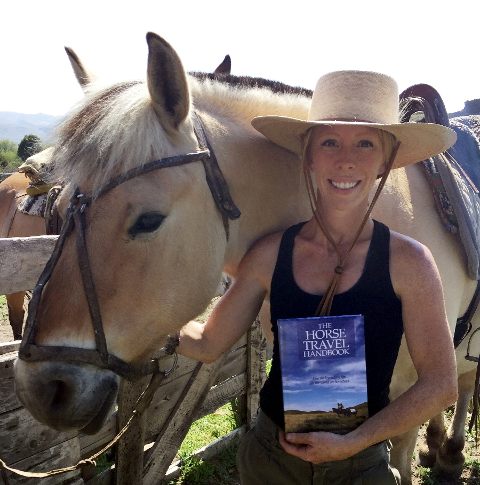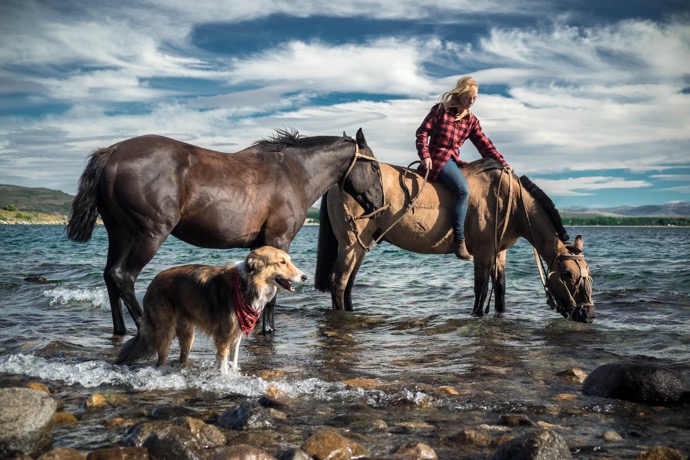21 Rules for Buying a Horse
By Stevie Anna Plummer

|
21 Rules for Buying a Horse By Stevie Anna Plummer |
|
I couldnít be more excited to announce that the Patagone team is now complete as Darcie, Sundance, and I welcomed Bandido to the crew last week. Bandido did excellent on our first day together as I rode him across Bariloche nearly 30 miles to his new home at the ranch.

Horse shopping in Patagonia. Sounds like a horse-loverís dream come true. Three months later and I can tell you it was nearly anything but. Not only are folks down here not really that interested in selling their horses, but the ones they do decide to sell are often either half-wild or on their last leg. It's a very long process. Lots of sipping yerba mate with the locals, chatting to try and find out who might be willing to sell me a decent horse.
Regardless on whether youíre purchasing your horse in Texas or Tahiti, there are many things to look out for and consider when making your final decision. Hereís what Iíve come to learn these past few months while finding my two horses here.
1. Love at First Sight: Donít get wrapped up in colors, breed, names, etc. You need to keep a clear mind when purchasing your horse so that nothing goes unnoticed. Ignoring little cues in the beginning wonít help you in the long run, no matter how cute your potential horse may be.
2. Chatter: If the seller is over talkative take caution as thereís a good chance heís trying to distract you from seeing something. Ignore the endless chatter or even ask if you can take the horse to a quiet place to inspect him more thoroughly.
3. Grazing: This is a huge aspect when buying a trail or road horse. Donít search for a mountain horse in the desert and vice versa. You cannot expect a lowland horse to know how to forage and graze in the highlands properly. Always try to search for a horse that has adapted to the similar terrain that you are planning on riding and keeping him.
4. Stable Horses: Notice how your potential horse is upon arrival to the stall. Is he relaxed and calm? Do his ears perk up or does he pin them back or bolt in fear? Raising his head or seeing the whites of his eyes should all be taken into consideration as these are prime examples of a scared horse. Look around and see if the horse cribs or chews away at his stall. Theyíll do the same to a tree on the trail and thatís not a healthy habit.
5. Saddled Up: There were a couple of times that I arrived to a barn only to meet my potential horse tacked-up and ready to go for me. While one might think this is an act of kindness by the seller, itís most likely the very opposite. Not only can you not see how the horse acted when saddled (did he bolt and bite or was he calm?), but this prohibits you to inspect his back and cinch area. Itís one of the oldest tricks in the book, beware.
6. Sweat: If you arrive and the horse is already covered in sweat or even a dry sweat (you can tell because the hair will appear hard and crusted over with salt), take this as a big caution sign. This is most often the result of a seller whoís gone out and ridden the horse into the ground in order to mellow him out for your ride. Only a green or a problematic horse will require this.
7. Tied Up: How is he tied? Loose or tight? A horse that is known to pull back or Ďsití when tied will most likely not be tied very close to anything. If you see a horse loosely tied up when you arrive, ask the owner if you can tie him closer to the post and saddle him up that way. If he disagrees then you know the horse spooks or pulls back when tied up to something, which is a huge issue to deal with. You wont be able to tie him to a fence on the trail, to open a gate, to a trailer, etc.
8. Owners: Seeing a horseís owner history will give you good insight to how he was raised and treated. Ask the current owner how long heís had the horse and why heís selling it. See how he treats his other animals and how he rides.
9. Stolen Horses: This isnít a problem everywhere, but was something I had to consider when shopping around in South America.
In Argentina, horses will often come with a libreta, a book of ownership, vaccination history, age, and breed of a horse. Youíll need this to cross provinces and borders when traveling. If the horse doesnít have a brand, isnít posted publicly (Facebook, etc.), or doesnít have any documentation of ownership, chances could be that he is a stolen horse.
10. Herd-Bound: A plus side of my search in Patagonia is that often horses here are trained as working horses. They are used to manage estancias, or large ranches, and can ride out alone without any other horses confidently. In general, horses are used to being with their herd and can struggle leaving home. I once test-rode a horse that wouldnít go further than a 100 foot radius of his barn. Be sure that when you do eventually ride out that they arenít barn shy and can manage a calm walk on their return home.
11. Good Days & Bad Days: Horses have moods. Donít bet that youíre going to know a horse the first time you take him out. I will ride a horse at least 3 times before making the purchase. I typically start with the first ride around the ranch and then after I will take them out on a busy street. Lastly, I will do a longer ride followed by a vet check both while I ride the horse and then after the ride to check for any swelling or lameness.
12. After the Ride: Be sure to check out the horseís legs after a long ride. Are they hot or swollen in any areas? A horse will often drop his head when stepping onto an unsound hoof and then raise it back up when on their sound hooves.
13. Temperament: How is his overall attitude? Can you saddle him from both sides? Does he take the bit easily? Be sure you can pick up all four of his feet without issues.
14. Road Worthy: I cannot stress this enoughÖ Your potential horse may be just fine close to home or out on the trail, but finding a horse that can ride along or even cross a street with no problems can be a big challenge. Horses are often terrified of the yellow lines on the street. People will honk at you. Itís a fact. Folks love seeing horses out and want to say Ďhelloí while often not realizing how terrorizing it can be to them. You need to be sure that your horse can keep calm and carry on in a normal manner in all circumstances.
15. Hobbles: This is especially important if you decide to camp with your horse. Be sure he can be both hobbled and kept on a long lead line overnight without issues.
16. Lameness: Riding a horse over pavement on a trot is a good way to check for lameness in any feet.
17. Vet Check: This is typically my last step before buying a horse. You absolutely need a veterinarianís eye to check a horse thoroughly over before you make the purchase. Heíll look over ligaments, back, eyes, teeth, muscles, etc. Do not buy a horse without having a professional check first.
18. Teeth: Check to see a horseís teeth. This is important while grazing on the trail and for general, overall health. If a horse has bad teeth, heíll be that much more difficult to feed on the trail and will lose weight quickly.
19. Damage: Check for any damage over his back and cinch areas by looking for small white spots which indicate either saddle or cinch damage. This happens when an area gets pinched or rubbed over time. Run two fingers along either side of his spine while watching how he reacts. Do you feel any large lumps or does he raise his head or pin his ears back in pain?
20. When You Ride: See how your potential horse is while mounting. Does he stand calm or turn in circles or try to bolt? Can you mount and dismount from either side? During your ride, try throwing a hand up in the air to see if he bolts or jumps. Pet him from the neck all the way down near his rump during your ride and see how he reacts.
21. Clothing: Try wearing a noisy rain jacket. Many horses are terrified of the sound of these types of materials or plastic. I once couldnít even catch a horse I was looking at potentially buying because of the type of coat I was wearing. At some point, youíll probably be riding in rain, so be sure that your horse wont take off with you if you decide to dress for the weather.
More Resources: The Horse Travel Handbook, by CuChullaine O'Reilly, The Long Riders Guild